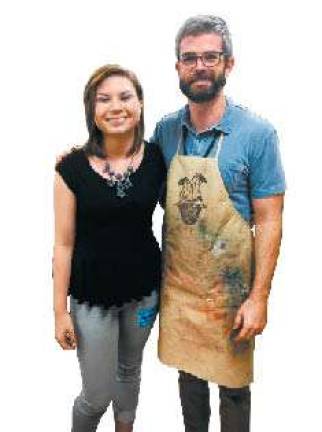A Home for Controversial Art

An exhibition of teenage artists includes previously censored work
Lower East Side When South Carolina teenager Gracie Holtzclaw created a black and red linocut print for her art class, the piece was selected for a recent county-wide art show. Two days before the opening, she found out her print was banned from the exhibit.
Titled "Rape Culture," Holtzclaw's print of a nude woman with a black censor bar covering her breasts, is her response to the sexual assault she experienced two years ago. Through an email to her art instructor, she was told the title and visual content in the piece were inappropriate for the show.
"All I really wanted to do was have this outlet," said Holtzclaw, 18. "And I wasn't able to do that anymore. I almost felt like something had been taken away from me."
Now, Holtzclaw's art can speak for itself, as gallery-goers in New York City have the opportunity to view her print, along with work by other young artists, in the upcoming "Green Light" exhibition put on by Teen Art Gallery, a teen-run organization that provides a platform for young artists.
T.A.G received over 800 submissions for the exhibit. "Green Light" features artists from 14 states and 40 pieces in different mediums, including photography, sculpture and creative writing.
Charlotte Bravin Lee, the director of T.A.G and a senior at the Ethical Culture Fieldston School in Riverdale, invited Holtzclaw to participate in the show.
"I'm a female the same age and about to head off to college," said Lee, 18, who will attend Kenyon College in Ohio come fall. "I'll have to be independent and thinking about my own safety, and her title 'Rape Culture' is particularly relevant. It's just a creative expression of anger and rage. And the piece was also beautiful, and I felt the need to show those who assault that they can't win."
Holtzclaw, who just completed her senior year at Blue Ridge High School in Greenville County, S.C., said she was afraid to tell anyone, even her parents, about the assault. When she did speak out, she was told she played a role in her own abuse.
"Everyone told me it was my fault because I put myself in a bad situation," said Holtzclaw, who was encouraged by her art teacher to create the piece. "I had never really coped with that all the way, and art was really a place where I could have an outlet and express myself."
Downtown artist Audrey Banks founded T.A.G in 2011, and when she first looked for galleries to host the organization's exhibits, she said some venues were turned off by the explicit content in some of the work.
"They thought a lot of what we'd show would be pure and relatively PG," said Banks, 20, who attended Bard High School Early College on Houston Street and now studies art at Carnegie Mellon. "The whole point of the organization [...]was about treating these young people equivalently to other artists."
Amy Barth, founder of Camp CADI, a summer camp for survivors of child sexual abuse, said that young women who have been abused often develop unhealthy coping methods, such as substance abuse, eating disorders or cutting, and that expressive art should be encouraged, not censored.
"Kids don't always have the words, but through different mediums they can express what they need to," said Barth. "It's very important we stop shying away from this topic."
Holtzclaw is working on new pieces for a local Greenville show of work that addresses violence against women.
"My message was almost, girls shouldn't have to censor themselves and be responsible for covering up and monitoring their actions to prevent being raped or sexually assaulted," Holtzclaw said.